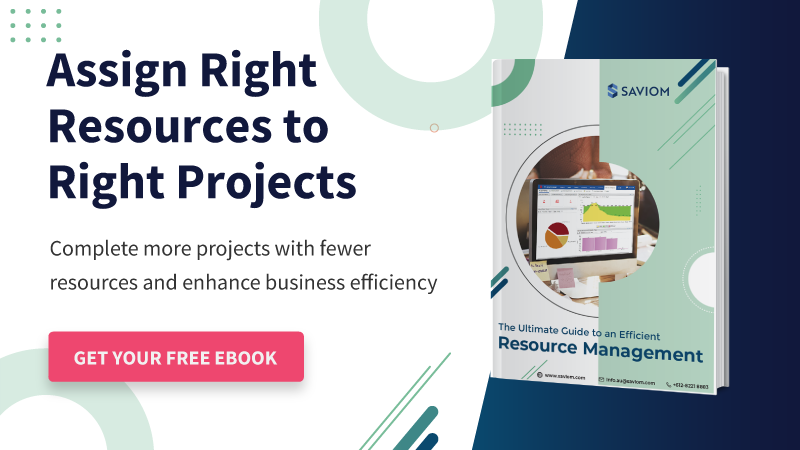Managing a construction project is no easy feat. With the constant juggling of schedules, equipment, manpower, and unpredictable factors like weather changes, fluctuating material costs, and coordinating temporary contractors, project managers often face numerous challenges that can derail progress.
This is where effective construction resource management becomes crucial. It involves the careful planning, allocation, and optimization of resources such as labor, materials, or machinery to ensure projects are completed on time, within budget, and to the highest quality standards.
Moreover, it enables project managers to anticipate and navigate risks, adapt to changing conditions, and maintain momentum throughout the project lifecycle.
This article explains the nitty-gritty of construction resource management, offering practical insights and best practices to improve ROI.
But before diving deep, let’s first understand the definition.
What is Construction Resource Management?
Construction resource management is the process of planning, allocating, and managing resources, including personnel, equipment, materials, and finances, to complete construction projects successfully.
Its primary goal is to meet project resource demands promptly while ensuring every resource is used productively throughout the organization.
Now, let’s go through its different types.
Types of Construction Resource Management
There are two types of construction resource management, i.e., operational and strategic. Let’s explore them in detail.
Operational Construction Resource Management
The operational construction resource management focuses on the day-to-day planning, allocation, and utilization of resources such as manpower, materials, equipment, and finances on a construction site. Its primary goal is to ensure resources are available when needed to meet immediate project demands.
Strategic Construction Resource Management
Strategic construction resource management involves long-term planning, budgeting, and resource allocation strategies to ensure the project’s success. This approach entails a comprehensive analysis of an AEC firm’s current capabilities, anticipates future needs, and external factors that may impact resource availability.
Now, let’s delve deep into the essential construction project management resources.
Read more: Resource Management: A Comprehensive Handbook for Project Managers
Types of Resources in Construction Management
Here is a rundown of all the essential types of resources required in the construction industry.
Human Resources:
Focusing on human resources, let’s delve into the specific roles involved in a construction project:
Estimator: The estimator is responsible for estimating the costs, materials, and labor needed to complete a project. They analyze project plans, specifications, and other documentation to prepare accurate cost estimates.
Architect: The architects translate client requirements and preferences into detailed architectural plans, blueprints, and drawings. They ensure the design is functional and complies with building codes and regulations.
Supervisor: The construction supervisor, often referred to as a site manager or foreman, acts as the bridge between the project manager and the on-site workforce, ensuring that the project progresses smoothly and efficiently.
Quantity Surveyor: They manage the financial and contractual aspects of a construction project. Their duties include preparing cost estimates, managing contracts, overseeing procurement processes, and controlling project costs.
Engineer: Civil, structural, electrical, and mechanical engineers are responsible for the technical aspects of the project, ensuring that the design and construction meet the required specifications and standards.
Construction Worker: Construction workers are the driving force of every project. This category includes skilled laborers, such as carpenters, masons, electricians, plumbers, and general laborers who assist with various on-site tasks.
Non-human Resources:
Enlisted below are some of the important non-human resources required in the construction industry:
Equipment: Construction projects require heavy equipment to perform various tasks that would be difficult or impossible to do manually. This includes bulldozers, cranes, excavators, loaders, drills, saws, and concrete mixers.
Materials: Materials are the physical substances used to construct the project. These include building materials such as concrete, steel, wood, bricks, cement, clay, glass, and finishing materials like paint, tiles, and fixtures.
Facilities: As per the CDM regulations, all construction sites must include the infrastructure and services necessary to support the workforce and operations on a construction site. This includes site offices, storage areas, workshops, worker accommodations, restrooms, and security systems.
Now that we know the resources required in construction projects, let’s understand the benefits of effective construction resource management.
Benefits of an Effective Construction Resource Management
Construction resource management provides an array of benefits. Here is a list of some prominent ones:
Reduces Construction Project Costs
An efficient construction resource management framework allows resource managers to leverage cost-effective AEC resources for their projects. Additionally, it ensures that the right amount of labor, materials, and equipment are available at the right time. This helps avoid overstaffing, underutilization, or excess inventory, which can lead to unnecessary costs.
Read more: 5 Ways to Reduce Project Management Costs
Helps Plan Construction Pipeline Project Activities
A robust construction resource management process allows managers to foresee AEC pipeline project demands. They can conduct a capacity vs. demand analysis to identify resource excesses and shortages in advance. Accordingly, managers can apply appropriate resourcing treatments to bridge the gap. This helps them avoid last-minute firefighting activities and create a skilled construction resource pool ahead of time.
Ensures Competent Allocation of Construction Resources
An effective construction resource management plan provides a comprehensive view of resources, including their key attributes such as capacity, availability, competencies, cost rate, etc. This detailed overview lets managers understand employees’ skills, preferences, and schedules. As a result, they can assign appropriate construction resources to suitable projects, ensuring competent allocation and optimal project outcomes.
Read more: Resource Allocation: A Guide on How to Apply it to Project Management
Improve Productivity of Construction Resources
An effective construction resource management process allows managers to monitor the overall utilization of the workforce and ensure that they are not under or overloaded. In case of discrepancies, they can take appropriate measures to balance the workload and maintain a healthy resource index. Therefore, it prevents burnout and disengagement, leading to higher workforce productivity and better project performance.
Facilitates Collaboration Among Team Members
Team collaboration is necessary to ensure seamless project execution and timely delivery. The construction resource management processes enhance collaboration by fostering open communication between project stakeholders. It ensures everyone is on the same page and aware of their individual and collective responsibilities to make the project successful.
Read more: 5 Ways to Improve Collaboration Between Departments
Forecasts Resource-related Risks in Advance
AEC projects are subject to numerous resource-related challenges, such as skill obsolescence, sub-optimal utilization, burnout, unplanned attrition, etc. These bottlenecks can be mitigated with a robust construction resource management framework. Managers forecast potential resource-related risks and create contingency plans in advance. For instance, they can develop training/upskilling modules to build a proficient construction workforce and mitigate last-minute shortages.
Now, let’s look at the various challenges faced by the AEC firm.
Challenges in Construction Resource Management
Numerous roadblocks in construction resource management can cause missed deadlines and cost overruns. Here are some critical challenges that the AEC industry faces.
Inability to Foresee Future Project Demands
When supervisors lack insight into the pipeline AEC projects, they may struggle to predict future resource requirements, including the types, quantity, and quality of resources needed for successful completion. This leads to last-minute firefighting to acquire the necessary personnel. Consequently, they are unable to initiate the project on time and meet the delivery deadlines.
Shortage of Skilled Labor
Skilled labor plays a vital role in the success of every construction project. But, with the increasing demand for construction services and technological advancements, there is a shortage of competent resources. Factors that influence the skill availability include:
- Lack of new generation workers willing to join the industry.
- Retirement of aging construction workers.
- Migration of employees to different sectors and fields.
- Growing skill obsolescence within the AEC workforce.
This talent crunch leads to high-cost recruitment, project delays, sub-par deliverable quality, and other issues.
Read more: How to Reduce Absenteeism in the Workplace?
Sub-optimal Resource Utilization
In the absence of proper tools and techniques, construction managers fail to track resource utilization in real-time. Sometimes, they end up overbooking a resource, resulting in overutilization and burnout. Conversely, they may underutilize some resources, which leads to disengagement. This sub-optimal utilization of construction employees not only affects overall productivity but also impedes project progress.
Changes in Project Scope Due to Various External and Internal Factors
Construction projects are susceptible to changes due to environmental factors like regulatory changes, weather conditions, and market volatility. Moreover, internal factors such as process delays, equipment failures, and improper change management processes can also impact the project scope. This can adversely affect resource productivity and increase workload. In addition, it leads to burnout and turnovers as resources get overwhelmed with last-minute changes. Managers also face a massive resource crunch and struggle to find suitable staff at the last moment.
Read more: Enterprise Risk Management Framework: 8 Core Components
Delays in the Procurement of Materials or Equipment
In the AEC industry, delays in procuring materials or equipment can significantly disrupt project timelines and stretch the budget. Such delays may stem from supply chain issues, vendor reliability problems, or logistical challenges. Moreover, these procurement setbacks can lead to stalled construction activities and affect the firm’s ability to meet project commitments efficiently.
Poor communication & Collaboration
Lack of effective communication and collaboration between construction teams can severely affect project workflow. Without clear and effective communication, team members may not be aware of project updates, changes, or issues, resulting in inconsistencies in work, misunderstandings, or errors. This lack of coordination can hamper decision-making, reduce productivity, and ultimately compromise the project delivery.
Usage of Outdated & Legacy Tools
The reliance on outdated and legacy tools can be a significant bottleneck as these solutions fail to efficiently address construction resource management challenges. These tools often lack integration capabilities and real-time visibility, leading to fragmented data and inefficient workflows. Moreover, they can be time-consuming and error-prone, resulting in scheduling conflicts such as double bookings.
Since we now understand the challenges related to construction resource management, let’s learn about the best practices to mitigate them.
Read more: How Outdated Resource Management Tools Are Hurting Businesses?
Best Practices for Effective Construction Resource Management
In the AEC business landscape, managers often manage multiple projects amidst tight timelines and budget constraints. This is when effective management of resources becomes critical for success.
The following are the best practices firms can adopt to manage resources efficiently.
Create an Accurate Project Resource Plan
Creating an accurate project resource plan is crucial for AEC firms to ensure project success. This process begins with understanding the project scope and creating a Resource Breakdown Structure (RBS) based on that. It enables managers to outline all resources needed to complete the project and categorize them by function and type.
This detailed breakdown provides visibility into what is required at each stage of the project’s development lifecycle. It also helps identify potential resource shortfalls early in the planning process, allowing for proactive efforts to secure extra resources as needed.
Anticipate & Raise Resource Requests Ahead of Time
Given the complex nature of AEC projects, firms must plan ahead and ensure they have the right resources available before project initiation. Therefore, once the RBS is developed, project supervisors will begin the resource requisition process. They will send the requests to resource managers, who will investigate whether the requisite skills exist within the internal pool.
Suppose there is a shortage of construction workers. In that case, resource managers can implement remedial measures such as initiative training/upskilling programs, conducting planned hiring, or enforce an out-rotation and backfill strategy. This proactive approach helps to address skill shortages and eliminates last-minute hiring.
Read more: How to Implement Effective Resource Capacity Planning in AEC Industry?
Allocate Competent Workforce to Suitable Tasks
With an effective project resource planning process, supervisors can identify and deploy AEC personnel to suitable tasks based on their experiences, skills, competencies, etc. For instance, a construction project requires skilled carpenters to complete the intricate woodwork in the interior spaces.
With complete visibility into the resource-related information, supervisors can quickly narrow their search and choose the right workers for the specific tasks, thereby ensuring competent allocation. This ensures the projects are completed within the stipulated timeline and budget, improving client relations.
Manage Ramp-up & Ramp-down of AEC Resources Effectively
In the dynamic AEC landscape, projects consistently experience a surge and decline in workforce demand. For instance, during the execution phase, supervisors may mobilize a substantial workforce to meet the project’s requirements. However, as the project nears its closure, several workers are released from their tasks at once and end up on the bench.
This leaves a significant part of the resource pool without work, adversely affecting the firm’s profitability. However, by gaining foresight into project ramp up and ramp down phases, supervisors can allocate suitable work to resources before they hit the bench. Moreover, they can provide partially skilled AEC employees shadowing and on-the-job training opportunities, improving their billable utilization and productivity.
Read More: How to Balance Ramp-Ups and Ramp-Downs in a Project?
Monitor & Optimize Utilization Levels of Construction Workforce
Managers can leverage real-time utilization reports and color-coded heatmaps of robust resource management software to identify instances of under or overloading. In the case of resource underutilization, supervisors can allocate more work to the resources by bringing forth pipeline projects or selling excess capacity at a discount. On the contrary, the resource overutilization can be mitigated by applying optimization techniques such as resource leveling and smoothing
Resource smoothing ensures a consistent workload for the project team by adjusting tasks’ start and end dates based on their availability. Conversely, the resource leveling technique adjusts the float tasks and redistributes the workload or adds extra personnel without affecting the critical path. This helps maintain the resource health index, improve productivity, and ensure timely project delivery.
Provide Training & Development Opportunities as Per Requirement
AEC firms must develop tailored training and individual development Plans (IDPs) for each employee. By carefully considering the employees’ skills, competencies, proficiency levels, etc., supervisors can offer IDPs that align with their career objectives and the firm’s strategic vision.
Consequently, this helps ensure the workforce is well-prepared to meet the constantly evolving demands while increasing job satisfaction and retention. Moreover, it fosters a positive company culture and solidifies the firm’s reputation as an industry leader committed to the growth and success of its professionals.
Read More: How Can Retraining/Upskilling Future-Proof Your Workforce?
Leverage a Construction Resource Management Software
AEC organizations must utilize robust resource management software that offers a comprehensive overview of the workforce on a single platform. This allows managers to schedule the right construction workers for the right projects at the optimal time and cost. Additionally, the tool helps maintain an up-to-date competency matrix, giving managers a thorough view of resources’ professional attributes. Consequently, they can create appropriate Individual Development Plans (IDPs) as needed.
Moreover, the software’s advanced functionalities enable managers to forecast and monitor critical KPIs such as capacity, demand, availability, utilization, and project financials. They can compare actual numbers against forecast values and implement corrective measures to address deviations. Furthermore, it provides a collaboration platform for seamless and effective communication among team members. Thus, ERM software can optimize the AEC workforce and enhance construction project delivery.
Conclusion
Construction resource management can be tricky. However, with proper resource scheduling and planning, managers can maximize productivity and ensure minimal resource conflicts. By following the above-mentioned practices, AEC firms can create a robust construction resource management framework. This will help them deliver the projects successfully and maximize ROI.
So, what steps do you take to manage your AEC resources effectively?
The Glossary
Read more: Glossary of Resource Workforce Planning, Scheduling and Management
SAVIOM Solution
SAVIOM has over 20 years of experience helping multinational clients manage their resources effectively and efficiently. With over 20 years of experience, this Australian-based MNC has a global presence across 50 countries and has helped 100+ clients meet their specific business goals. Saviom also provides tools for project portfolio management, professional service automation, and workforce planning software. So, SAVIOM can help your business to establish an efficient system geared toward your specific business challenges.













Leave a Reply